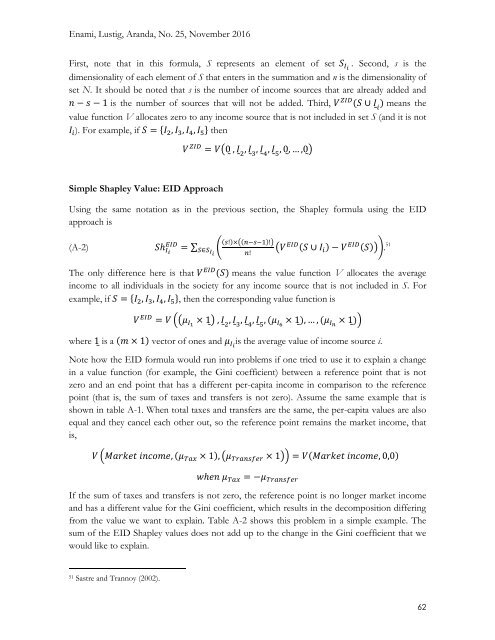IMPACT OF TAXES AND TRANSFERS
n?u=RePEc:tul:ceqwps:25&r=lam
n?u=RePEc:tul:ceqwps:25&r=lam
You also want an ePaper? Increase the reach of your titles
YUMPU automatically turns print PDFs into web optimized ePapers that Google loves.
Enami, Lustig, Aranda, No. 25, November 2016<br />
First, note that in this formula, S represents an element of set S Ii . Second, s is the<br />
dimensionality of each element of S that enters in the summation and n is the dimensionality of<br />
set N. It should be noted that s is the number of income sources that are already added and<br />
n − s − 1 is the number of sources that will not be added. Third, V ZID (S ∪ Ḭ i<br />
) means the<br />
value function V allocates zero to any income source that is not included in set S (and it is not<br />
Ḭ i ). For example, if S = {Ḭ 2 , Ḭ 3 , Ḭ 4 , Ḭ 5 } then<br />
V ZID = V(0 , Ḭ 2<br />
, Ḭ 3<br />
, Ḭ 4<br />
, Ḭ 5<br />
, 0 , … ,0 )<br />
Simple Shapley Value: EID Approach<br />
Using the same notation as in the previous section, the Shapley formula using the EID<br />
approach is<br />
(A-2)<br />
Sh Ii<br />
EID = ∑<br />
( (s!)×((n−s−1)!)<br />
S∈S (V EID (S ∪ Ḭ<br />
n!<br />
i ) − V EID Ii<br />
(S))). 51<br />
The only difference here is that V EID (S) means the value function V allocates the average<br />
income to all individuals in the society for any income source that is not included in S. For<br />
example, if S = {Ḭ 2 , Ḭ 3 , Ḭ 4 , Ḭ 5 }, then the corresponding value function is<br />
V EID = V ((μ I1 × 1 ) , Ḭ 2<br />
, Ḭ 3<br />
, Ḭ 4<br />
, Ḭ 5<br />
, (μ I6 × 1 ), … , (μ In × 1 ))<br />
where 1 is a (m × 1) vector of ones and μ Ii is the average value of income source i.<br />
Note how the EID formula would run into problems if one tried to use it to explain a change<br />
in a value function (for example, the Gini coefficient) between a reference point that is not<br />
zero and an end point that has a different per-capita income in comparison to the reference<br />
point (that is, the sum of taxes and transfers is not zero). Assume the same example that is<br />
shown in table A-1. When total taxes and transfers are the same, the per-capita values are also<br />
equal and they cancel each other out, so the reference point remains the market income, that<br />
is,<br />
V (Market income, (μ Tax × 1), (μ Transfer × 1)) = V(Market income, 0,0)<br />
when μ Tax = −μ Transfer<br />
If the sum of taxes and transfers is not zero, the reference point is no longer market income<br />
and has a different value for the Gini coefficient, which results in the decomposition differing<br />
from the value we want to explain. Table A-2 shows this problem in a simple example. The<br />
sum of the EID Shapley values does not add up to the change in the Gini coefficient that we<br />
would like to explain.<br />
51 Sastre and Trannoy (2002).<br />
62



